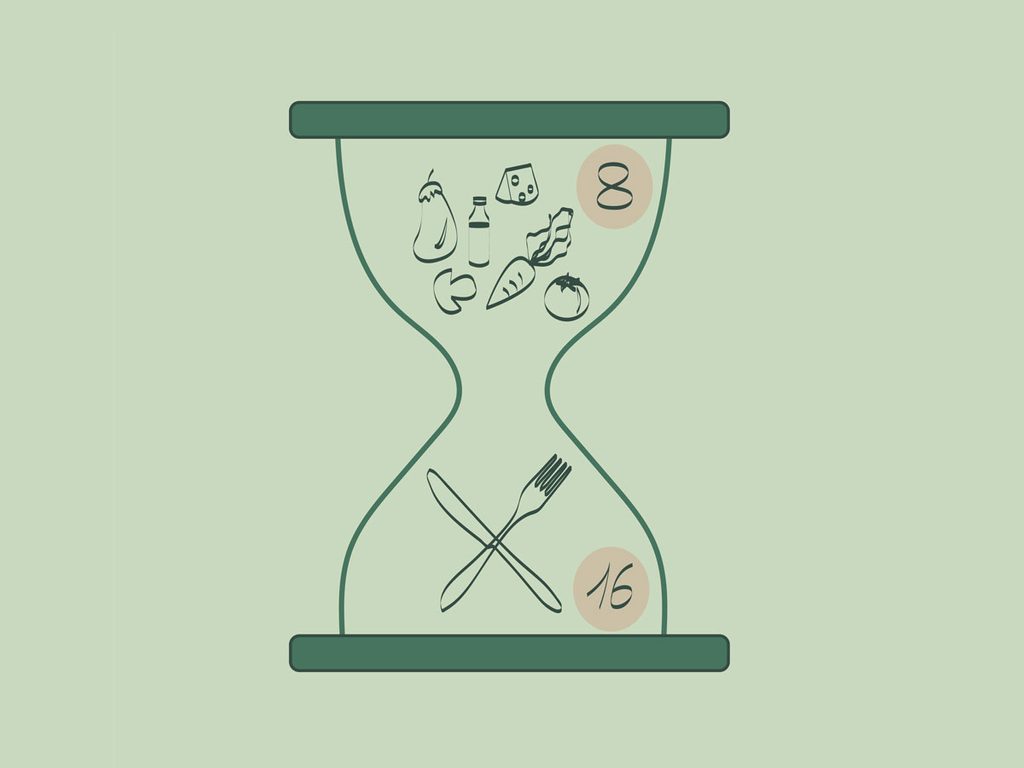Everything You Need to Know About Intermittent Fasting

It can be confusing to know what to eat and when with intermittent fasts. Here's an intermittent fasting schedule guide to help you navigate.
With bold promises of weight loss, type 2 diabetes reversal, enhanced mental clarity, longevity, and more, it’s no wonder intermittent fasting is so popular. In fact, “intermittent fasting” ranked first on Google’s diet search trends for 2019. But not all fasting plans are the same. Intermittent fasting schedules can differ in terms of the type of fast, what you can eat, and when you can eat it. Each has pros and cons along with different celebrities and authors who are fans.
Precisely when intermittent fasting took off is unclear, says Krista Varady, professor of nutrition at the University of Illinois, Chicago and author of The Every-Other-Day Diet. Varady believes the simplicity of these eating plans has a lot to do with their popularity.
“People were burnt out from carb counting and other weight loss methods,” says Varady, who has been researching intermittent fasting for decades. “All you need for intermittent fasting is a clock. If you have access to the time, you can do these diets.” Before you start, read more on the difference between alternate day fasting and intermittent fasting.
Alternate day fasting
With this type of fast, you eat every other day and consume no or very few calories on the days in between. “It’s a feast day, fast day, feast day and so on,” Varady explains.
Typically, on fasting days, people consume no more than about 25 percent of their usual caloric needs (about 500 calories). Alternate day fasters can lose as many as 10 to 15 pounds in three months, she says. “It’s harder to follow than other types of intermittent fasting because you have to count calories every other day,” she notes.
There was concern that alternate day fasters would overeat on feast days, negating some weight loss benefits. “We have shown that fasters only eat 10 percent more on feast days,” she says. “They get control of hunger and don’t go crazy on feast days.”
There’s nothing magical about this way of eating. “The reason you lose weight is because you are eating less food,” she says.
Weight loss isn’t the only potential benefit of alternate day fasting, Varady says. “We see regular reduction in blood pressure, fasting glucose levels, and insulin resistance with all types of intermittent fasting.” High fasting glucose and insulin resistance, which occurs when cells fail to use this hormone efficiently, increase diabetes risk. If or how fasting affects dangerous blood fats known as triglycerides and low-density lipoprotein or bad cholesterol levels, is pretty variable. “Generally, if people have high levels of these, we do see improvements.”
Modified fasts
Modified fasts like the popular 5:2 fast are a spin-off of alternate day fasting, Varady says. The 5:2 intermittent fasting schedule calls for fasting two days per week and following your usual eating patterns on the other five days. You can choose which days you want to fast as long as there is at least one non-fasting day in between them. On the days you fast, you limit yourself to between 500-600 calories.
Weight loss and other benefits tend to be similar to what is seen with alternate day fasting, Varady says. The goal is to make healthy choices on feast days, including more vegetables and fewer processed foods, she adds.
(Related: The Healthiest Foods to Eat in Every Decade of Your Life)
Time-restricted fasting
This popular means of intermittent fasting limits calorie intake to specific hours. The goal is to fast eight to 12 hours per day with the majority of the fast occurring during sleep. One popular method is 16:8, meaning you can eat for eight hours and then fast for 16. You might, for example, only eat between 7 a.m. and 3 p.m., or between 11:30 a.m. and 7:30 p.m.
There’s also the 14:10 method where you are allowed to eat whatever you want during a 10-hour window. With this method, you might eat only between 7 a.m. and 5 p.m.
Meal skipping also can be considered at type of time-restricted fasting. These fasts can be repeated whenever and as often as you like.
They work because your body uses up the glucose stored in your liver for energy when you fast and then you start burning fat for energy, says Mark P. Mattson, adjunct professor of neuroscience at Johns Hopkins University School of Medicine, Baltimore. It’s this “metabolic switch” that is responsible for all of the benefits, namely weight loss and reductions in risks for diseases, he explains.
Slower weight loss
Weight loss tends to be slower with time-restricted feeding than other types of fasting, Varady notes. The average loss is about six to seven pounds over three months, she says. But it is much easier to follow than alternate day fasting. With this intermittent fasting schedule, “You have a window you can place anywhere in the day that you want that allows you to cut out at least 500 calories a day without counting,” she says.
But at least one recent study found that 16:8 may not be worth the hype. The research, which appears in JAMA Internal Medicine in September 2020, found that while people who fast practiced this type of intermittent fasting lost as much weight as people eating three controlled-calorie meals per day, the people in the fasting group tended to lose more muscle mass than their counterparts.
“With normal weight loss, you lose a third of lean or muscle mass and two-thirds fat mass for every pound, but we saw the opposite,” says study author Ethan Weiss, a cardiologist the University of California, San Francisco. The study was not designed specifically to detect differences in fat composition, and more research is needed to confirm this finding. “You want to maintain lean muscle mass throughout life,” Weiss says. “Older adults with reduced muscle mass are at greater risk for a host of diseases.”
Other intermittent fasts have “brand” names and are based on a specific book or protocol. They generally can be folded into the bigger categories of fasts, Varady says.
Eat Stop Eat
Popularized by Brad Pilon in a book with the same name, Eat Stop Eat calls for fasting for up to 24 hours once or twice a week. For the other five to six days, you eat what you want, but it’s suggested that you make healthy choices and try not to overeat.
You’ll still eat something on each day of the week with this method. If you decide to stop eating from Monday noon to Tuesday noon, for example, you’ll eat breakfast on Monday and dinner on Tuesday.
This is a version of alternate day fasting, Varady notes. The benefits are likely similar to those seen in other alternate-day fasting techniques.
The Warrior Diet
The Warrior Diet is essentially 20:4, meaning a 20-hour food fast and a four-hour feast, usually in the evening. This is a version of time-restricted eating. The diet was created by Ori Hofmekler after serving with the Israeli Special Forces. He believed this is the way people were designed to eat and it could lead to weight loss and increased energy.
Some nutritionists caution that the diet is not relevant today because we are not warriors and people can overeat unhealthy foods in that evening four-hour window. It can also be difficult to pack all the nutrients you need into such a small time period.
Fasting in general, however, makes sense from an evolutionary standpoint, says Mattson. In prehistoric days, animals ate when there was food and abstained when there wasn’t. The same was true of our ancestors, he says. “Our organ systems evolved so they function well on intermittent feedings.”
(Related: What Doctors and Nutritionists Wish You Knew About the Warrior Diet)
Water-only fasts
Water-only fasts are defined as “the complete abstinence of substances except for pure water.” They can last several days, but are not advised or particularly well studied, Varady cautions. It’s faster beware as drinking large quantities of water and not eating any food for days could lead to dangerous electrolyte imbalances, which causes fatigue, headache, and other symptoms.
You will lose weight on a water fast, says Scott Kahan, director of the National Center for Weight and Wellness in Washington, D.C. It’s just water weight that will come back when you start eating food again, he says. In general, he cautions, all types of fasting can cause headaches, fainting, weakness, and dehydration.
(Related: Signs You’re Already at a Healthy Weight)
Juice cleanses
Juice cleanses consist mainly of fruit and vegetable juices for a period of days. Advocates claim they produce weight loss and aid in the body’s detoxification process, but they can be risky. Some juices haven’t been pasteurized to kill harmful bacteria and can make you sick, while others are made from foods that are high in oxalates and can increase the risk for painful kidney stones.
Keto diets
Keto diets, low-carb diets, and other macronutrient “fasts” can be blended into fasting protocols, Varady says. When you cut carbs, your body will shift to fat for fuel. This raises blood levels of ketones. The liver produces these chemicals when there’s no sugar or glucose to fuel the body. This puts you in a state of fat-burning ketosis.
“When you combine alternate day fasting with low carb or other macronutrient-restrictive diets, most people lose even more weight—as much to 15 percent more—compared with fasting alone,” Varady says. Feast days just focus on low carb options as are fast days, she says.
(Related: Hidden Dangers of the Keto Diet)
Calorie restriction fasts
These intermittent fasting schedules involve cutting your daily caloric intake every day as opposed to just a few days a week. Daily calories can range from 800 to 1,200 a day. Most of the time these types of diets include bars, shakes, and other foods that are well-balanced. It works for weight loss, but it is only a short-term fix, Kahan says. “Hopefully it will help you develop a healthier way of eating over the long term.”
A quick word about fasting
Fasting is not for everyone, Varady says. This way of eating is not recommended for women who are pregnant or breastfeeding, anyone under the age of 25, individuals with an eating disorder, a seizure disorder, and/or those who operate heavy machinery on the job. “Always talk to your doctor before you make any major changes to your diet.”




